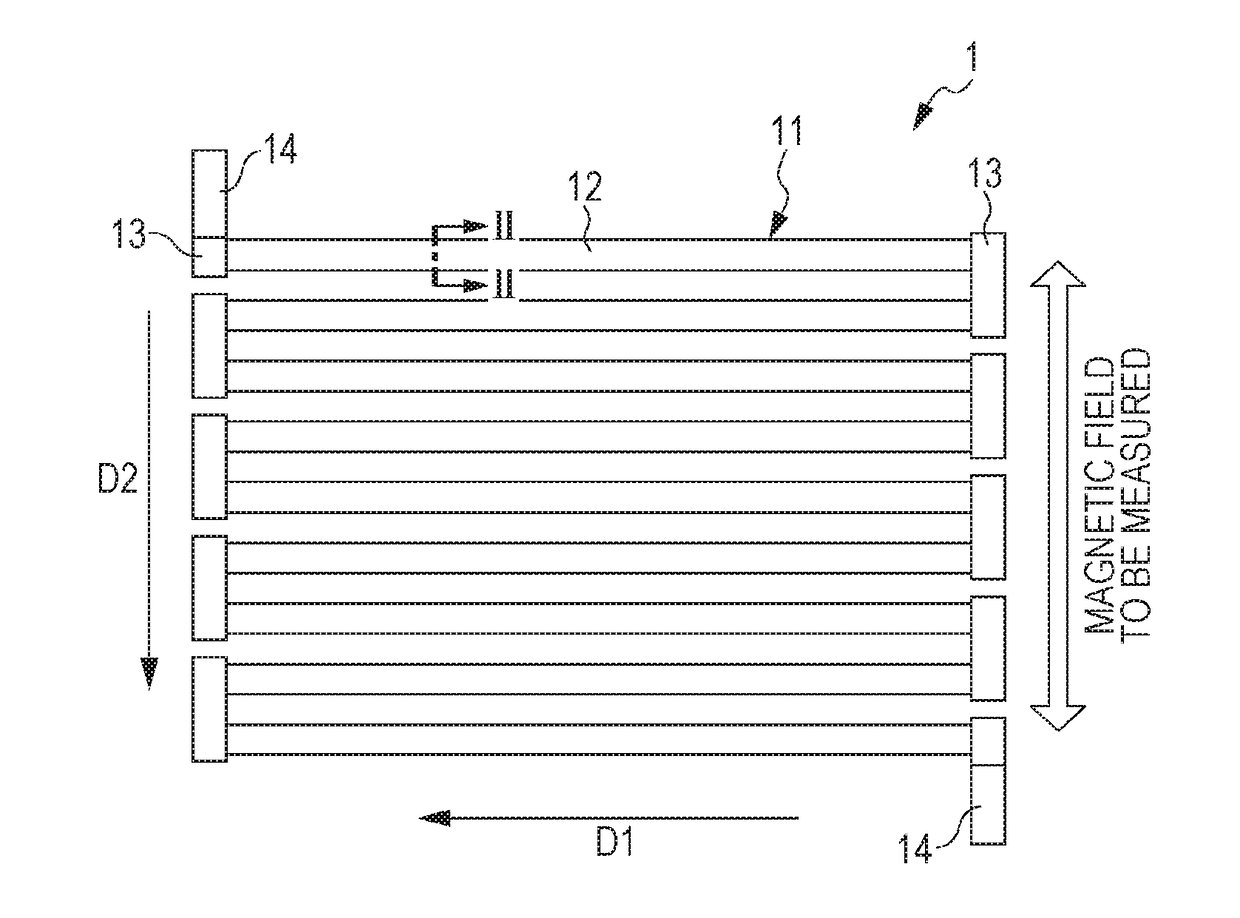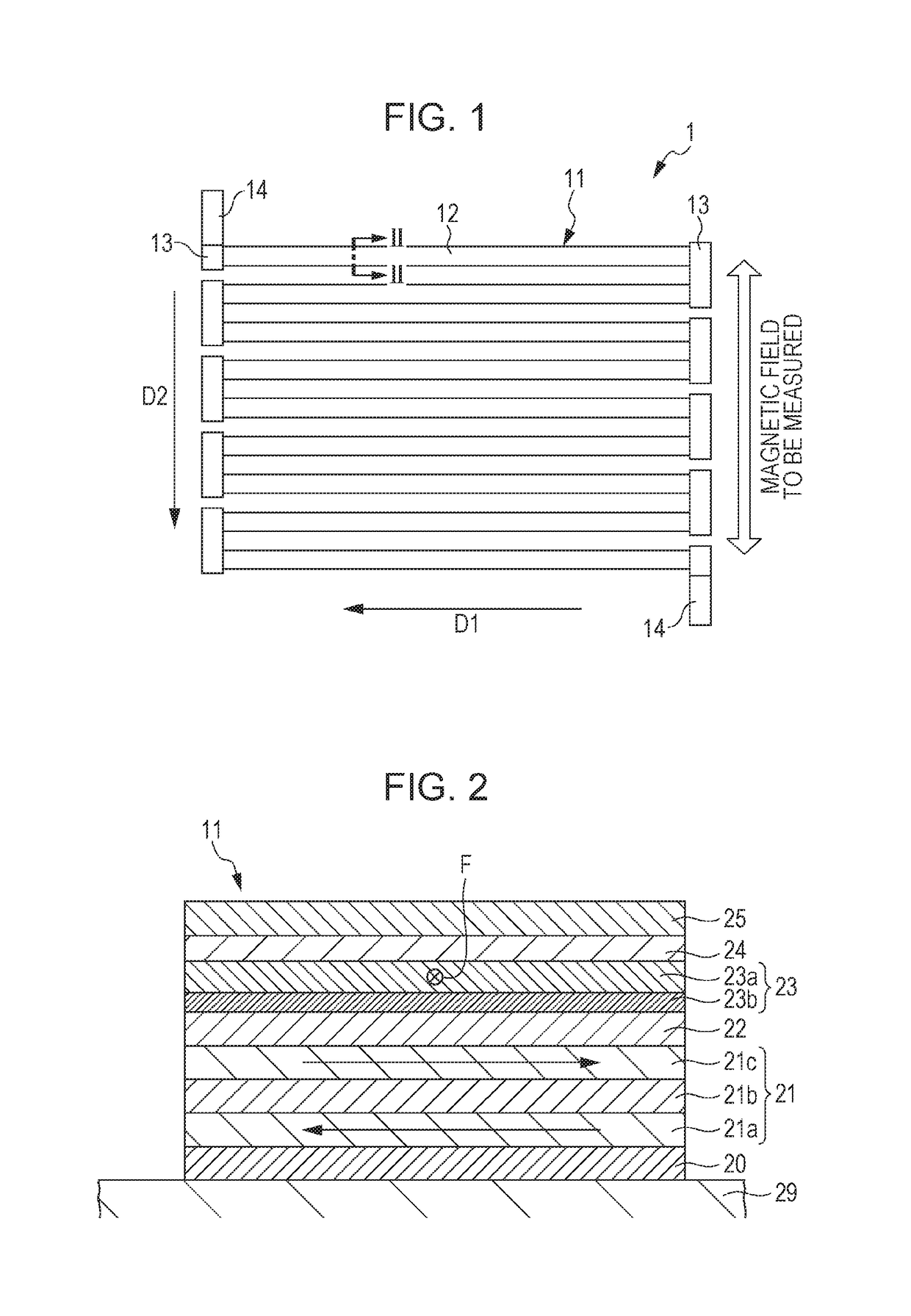Magnetic sensor and current sensor
a current sensor and magnetic sensor technology, applied in the field of magnetic sensors and current sensors, can solve the problems of reducing the bias generated in the free magnetic layer by the exchange coupling bias, and the detection accuracy of the gmr element may tend to decrease in some cases
- Summary
- Abstract
- Description
- Claims
- Application Information
AI Technical Summary
Benefits of technology
Problems solved by technology
Method used
Image
Examples
examples 1 to 4
[0079]On a substrate having an insulating film, a seed layer: NiFeCr (42) / fixed magnetic layer [first magnetic layer: Co40Fe60 (19) / nonmagnetic interlayer: Ru (3.6) / second magnetic layer: Co90Fe10 (24)] / nonmagnetic material layer: Cu (20) / free magnetic layer {second ferromagnetic layer: [Co90Fe10 (10) / Ni81.5Fe18.5 (10)] / magnetic adjustment layer: (Ni81.5Fe18.5)100-xPtx (Y) / first ferromagnetic layer: Ni81.5Fe18.5 (10)} / first antiferromagnetic layer: Ir22Mn78 (60) / protective layer: Ta (100) were sequentially laminated to each other from the bottom, so that a laminate structural body was obtained. The numerical value in the parentheses indicates the layer thickness, and the unit thereof is Å.
[0080]In addition, Y (thickness of the magnetic adjustment layer) was set so that when×(content of Pt in the magnetic adjustment layer) was changed, the magnetization amount (Ms·t) of the magnetic adjustment layer was equivalent to the magnetization amount (Ms·t) of the reference layer. In particul...
example 1
Measurement Example 1
Measurement of Reduction Rate RMs of Saturation Magnetization Ms
[0082]The saturation magnetizations Ms (unit: T) at 25° C. and 150° C. of the reference layer of Comparative Example 1 and the saturation magnetizations Ms at 25° C. and 150° C. of the magnetic adjustment layer of each of Examples 1 to 4 were measured. From the data thus obtained, the reduction rate RMs of the saturation magnetization Ms was obtained. In addition, the Curie temperatures of the materials forming the reference layer and each magnetic adjustment layer were measured. The results are shown in Table 2.
TABLE 2Curie temper-Ms atMs at ature25° C.150° C.RMsTca(T)(T)(%)(° C.)Comparative1.091.026.46580Example 1Example 10.780.5529.4372Example 20.620.3248.3275Example 30.450.1273.0162Example 40.240.0010045
[0083]As shown in Table 2, in the magnetic adjustment layers according to Examples, the reduction rate RMs of the saturation magnetization Ms was more than 10%. FIG. 5 is a graph showing the rela...
example 2
Measurement Example 2
Measurement of Exchange Coupling Bias Hex
[0084]The exchange coupling bias Hex (unit: Oe) of each of the relative laminate structural body of Comparative Example 1 and the laminate structural bodies of Examples 1 to 4 was measured by changing an environmental temperature. The results are shown in Table 3. In addition, based on the results shown in Table 3, the relative value of the exchange coupling bias Hex obtained by normalization using the result at 25° C. is shown in Table 4, and the result obtained by plotting the data shown in Table 4 is shown in FIG. 8.
TABLE 325° C.85° C.150° C.200° C.Comparative 42.1036.3020.9110.20Example 1Example 139.8036.0723.5013.66Example 240.0438.7231.1017.28Example 341.3741.7539.9821.18Example 441.810.000.000.00
TABLE 425° C.85° C.150° C.200° C.Comparative 10.860.500.24Example 1Example 110.910.590.34Example 210.970.780.43Example 311.010.970.51Example 410.000.000.00
[0085]As shown in Tables 3 and 4 and FIG. 8, it was confirmed that t...
PUM
| Property | Measurement | Unit |
|---|---|---|
| temperature | aaaaa | aaaaa |
| temperature | aaaaa | aaaaa |
| temperature | aaaaa | aaaaa |
Abstract
Description
Claims
Application Information
 Login to View More
Login to View More - R&D
- Intellectual Property
- Life Sciences
- Materials
- Tech Scout
- Unparalleled Data Quality
- Higher Quality Content
- 60% Fewer Hallucinations
Browse by: Latest US Patents, China's latest patents, Technical Efficacy Thesaurus, Application Domain, Technology Topic, Popular Technical Reports.
© 2025 PatSnap. All rights reserved.Legal|Privacy policy|Modern Slavery Act Transparency Statement|Sitemap|About US| Contact US: help@patsnap.com



